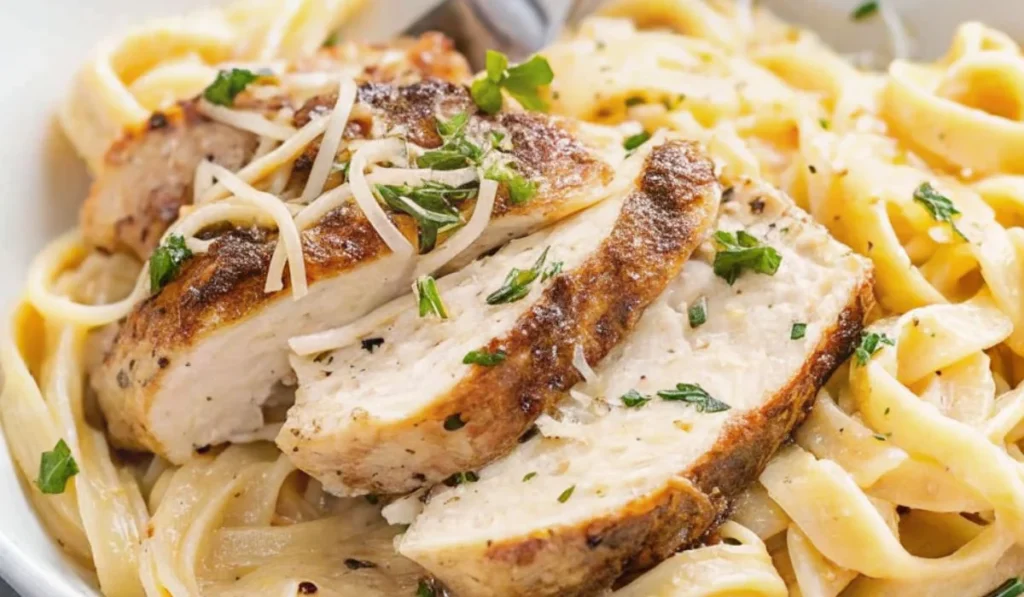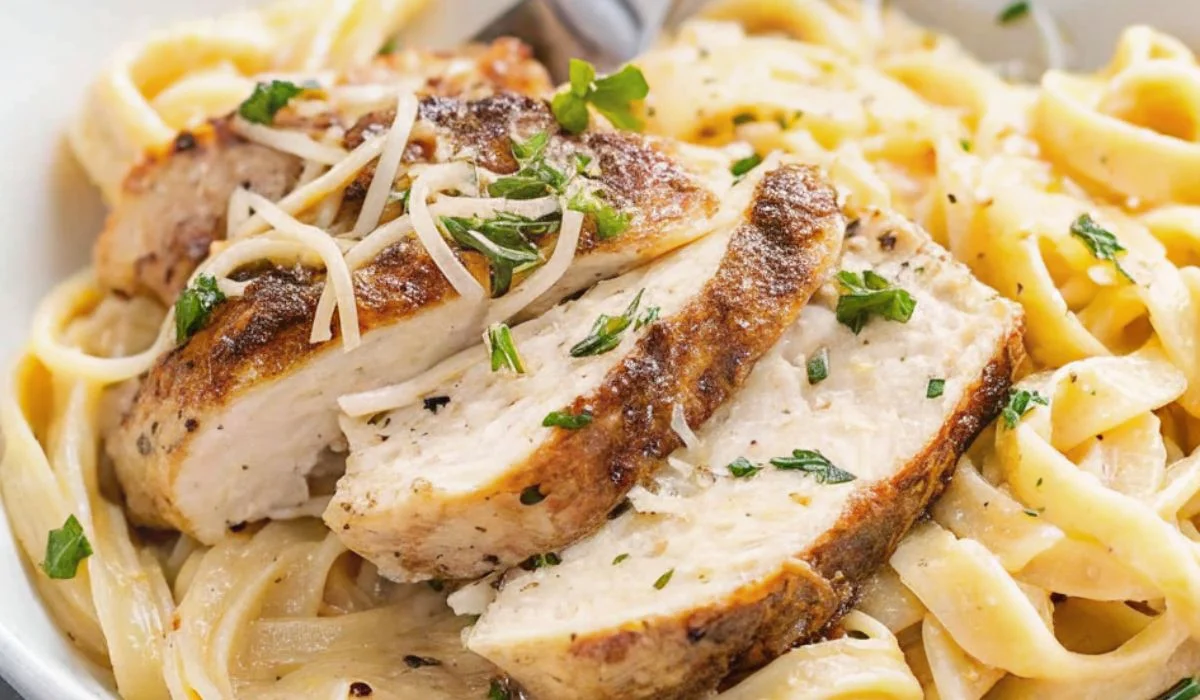This homemade Chicken Alfredo is rich, creamy, and full of flavor. It’s made with golden pan-seared chicken, tender pasta, and a smooth garlic-Parmesan cream sauce. Best of all, it’s ready in just over 30 minutes, making it perfect for busy weeknights or special dinners.
You’ll get restaurant-quality flavor from your own kitchen, with simple ingredients and easy steps.

Ingredients You’ll Need
For the Pasta
- 16 ounces fettuccine pasta
For the Chicken
- 1 pound boneless, skinless chicken breasts
- 1 teaspoon Italian seasoning
- 3/4 teaspoon kosher salt
- 1/4 teaspoon black pepper
- 2 tablespoons olive oil
- 1 tablespoon butter
For the Alfredo Sauce
- 1/2 cup butter (cut into pieces)
- 2 cups heavy cream
- 1 garlic clove (minced)
- 3/4 teaspoon garlic powder
- 3/4 teaspoon Italian seasoning
- 1/4 teaspoon salt
- 1/4 teaspoon pepper
- 2 cups freshly grated Parmesan cheese
How to Make Chicken Alfredo
1. Cook the Pasta
- Bring a large pot of salted water to a boil.
- Add fettuccine and cook according to the package instructions until al dente (about 10 minutes).
- Reserve 1/2 cup of pasta water, then drain and set the noodles aside.
2. Cook the Chicken
- Season chicken breasts with Italian seasoning, salt, and pepper.
- Heat olive oil in a large skillet over medium-high heat.
- Once hot, add chicken and cook for 5 to 7 minutes without moving it.
- Flip the chicken, add 1 tablespoon of butter, and cook another 5 to 7 minutes or until the internal temperature reaches 165°F.
- Remove the chicken from the skillet and let it rest for 3 minutes. Slice into 1/2-inch pieces and cover loosely with foil.
3. Make the Alfredo Sauce
- In the same skillet, reduce heat to medium-low.
- Add butter and cream, whisking until the butter melts.
- Stir in the minced garlic, garlic powder, Italian seasoning, salt, and pepper.
- Simmer gently for 3 to 4 minutes while whisking constantly, until the sauce starts to thicken.
- Add Parmesan cheese and stir until melted and smooth. If the sauce is too thick, add a little pasta water.
4. Combine and Serve
- Remove the skillet from heat and toss in the cooked pasta until fully coated.
- Divide the pasta among plates and top with sliced chicken.
- Garnish with more Parmesan, chopped parsley, and black pepper if you like.
Tips for the Best Chicken Alfredo
- Use fresh Parmesan: Grate it yourself for the smoothest, best-tasting sauce.
- Don’t overcook the chicken: Use a meat thermometer and aim for 165°F.
- Have everything ready: The recipe comes together quickly, so prep ingredients before cooking.
- Adjust the sauce: If it’s too thick, add pasta water. If it’s too thin, simmer a little longer or let it rest before mixing with the pasta.
- Lighten it up: Swap heavy cream with half-and-half or whole milk, though the sauce will be thinner.
Best Pasta for Alfredo
Fettuccine is the classic choice because the flat shape holds the creamy sauce well. You can also use linguine, penne, or even spaghetti.
Storage and Reheating
- Refrigerate: Store leftovers in an airtight container for up to 3 days.
- Reheat: Warm on the stove over low heat, adding a splash of milk or cream to loosen the sauce.
Nutrition (Per Serving)
- Calories: 919
- Carbohydrates: 45g
- Protein: 39g
- Fat: 65g
- Saturated Fat: 37g
- Cholesterol: 280mg
- Sodium: 1179mg
- Fiber: 2g
- Sugar: 2g
- Calcium: 462mg
- Iron: 2mg
- Potassium: 540mg
- Vitamin A: 2054IU
- Vitamin C: 2mg
FAQs
Can I make Chicken Alfredo ahead of time?
Yes, but the sauce is best fresh. If making ahead, store the pasta and sauce separately and combine when reheating.
Can I use pre-cooked chicken?
You can, but freshly cooked chicken tastes much better in this dish.
What can I add to mix it up?
Try adding sautéed mushrooms, steamed broccoli, or sun-dried tomatoes for extra flavor and texture.
This creamy Chicken Alfredo is a comforting, satisfying meal the whole family will love. It’s easy, delicious, and always a crowd-pleaser.

Chicken Alfredo
Ingredients
Equipment
Method
- Bring a large pot of salted water to a boil. Cook fettuccine according to package directions until al dente, about 10 minutes. Reserve 1/2 cup of the pasta water, then drain and set aside.
- Season chicken breasts with Italian seasoning, salt, and pepper.
- Heat olive oil in a large skillet over medium-high heat. Add chicken and cook for 5 to 7 minutes undisturbed until golden brown. Flip, add 1 tablespoon butter, and cook another 5 to 7 minutes or until the internal temperature reaches 165°F.
- Transfer chicken to a cutting board and let it rest for 3 minutes. Slice into 1/2-inch pieces and cover loosely with foil.
- In the same skillet, reduce heat to medium-low. Add butter and heavy cream, whisking until butter is melted.
- Add minced garlic, garlic powder, Italian seasoning, salt, and pepper. Whisk until smooth. Simmer gently for 3 to 4 minutes while whisking constantly, until slightly thickened.
- Stir in Parmesan cheese and whisk just until melted and the sauce is creamy. If too thick, add some reserved pasta water.
- Remove from heat and toss in the cooked pasta until evenly coated.
- Serve pasta topped with sliced chicken. Garnish with extra Parmesan, parsley, and black pepper if desired.
